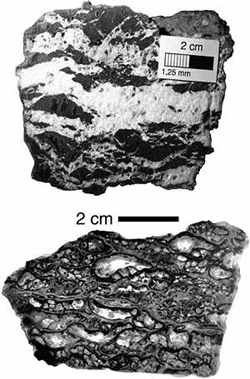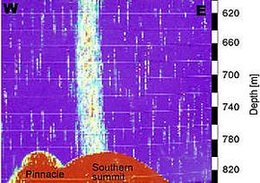Page path:
- General/Marine Geology
- Gas Hydrate Research
- Seafloor Samples
Seafloor Samples
Seafloor samples confirm the presence of gas hydrates in sediments, as indicated by BSRs. Most of the samples were retrieved from drilling ships within the international programmes DSDP and ODP, or from research vessels from shallow sediment. Once exposed to ambient temperature and pressure conditions on board, gas hydrate is not stable. It dissociates, and for this reason it is very likely that it often was not even noticed in the past. The only way to study gas hydrate samples in the laboratory is to either use pressurized sampling devices or to ensure extremely quick gas hydrate sampling on board and preservation in liquid nitrogen (-196°C).

Picture:
Natural gas hydrate structures sampled from Hydrate Ridge off Oregon from a water depth of 780 m: A cross section shows the distribution of pure gas hydrate (white), branching out into thin veins which penetrate the dark sediment. A thin section (bottom) of a layer of pure gas hydrate illustrates the porous, sponge-like structure.
Natural gas hydrate structures sampled from Hydrate Ridge off Oregon from a water depth of 780 m: A cross section shows the distribution of pure gas hydrate (white), branching out into thin veins which penetrate the dark sediment. A thin section (bottom) of a layer of pure gas hydrate illustrates the porous, sponge-like structure.
Particularly huge gas hydrate quantities were sampled by means of TV-guided grab from a water depth of 780 m at the southern peak of the submarine Hydrate Ridge off Oregon. Hydrate Ridge is an 15 km wide elongated accretionary ridge, extending about 30 km from north to south. It was formed by subduction of the oceanic Juan de Fuca plate beneath the North American continent. At its southern peak gas hydrates occur directly at the seafloor. A specific faunal community has settled here, supporting, for example, calyptogenic bivalves which perform chemosynthesis with microorganisms and thus use the methane of the hydrate as an indirect source of energy and food. Samples from Hydrate Ridge as well as from other sites in the Gulf of Mexico, the Sea of Okhotsk or the Black Sea, show a very heterogenous, interlocking structure of mostly white gas hydrate and sediments. Generally, gas hydrate occurs in various forms, ranging from finely dispersed lumps to massive, pure layers which are several centimeters thick. Other structures may consist of layers that wedge out, of interbeddings with thicknesses in the mm to cm range or of irregularly branching gas hydrate that completely dissolves the original sedimentary structure and leads to a formation of clastic sediments. Microscopic analyses of thin sections of pure gas hydrate show a sponge-like structure with strongly varying pore sizes. The pore structure is due to the upward movement of gas bubbles in the sediment. It is presumed that during this process a thin film of gas hydrate forms at the interface of the bubble with the pore water.
Gas bubbles migrating upward from the seafloor have been observed by submersibles and robots and have also been recorded in the water column by means of echo sounder systems. So far, the microstructure of gas hydrate has only been analyzed for samples taken from Hydrate Ridge. Nevertheless, based upon the frequent occurrence of gas bubbles in the water column in other regions, it can be assumed that near-surface gas hydrate found there also forms from upward moving gas bubbles.
Gas bubbles migrating upward from the seafloor have been observed by submersibles and robots and have also been recorded in the water column by means of echo sounder systems. So far, the microstructure of gas hydrate has only been analyzed for samples taken from Hydrate Ridge. Nevertheless, based upon the frequent occurrence of gas bubbles in the water column in other regions, it can be assumed that near-surface gas hydrate found there also forms from upward moving gas bubbles.

Picture:
Gas plume recorded acoustically in waters above the southern part of Hydrate Ridge, Oregon.
Gas plume recorded acoustically in waters above the southern part of Hydrate Ridge, Oregon.


